Proposal for Candidate Screening for HR Manager Role at Company T
VerifiedAdded on 2022/08/23
|11
|2937
|30
Project
AI Summary
This project presents a comprehensive proposal for screening candidates for an HR Manager position within a global organization, Company T. The proposal outlines a robust assessment strategy, integrating standardized tests such as the Hogan Personality Inventory, Multi-dimensional Aptitude Battery II (MAB), and the Miller Analogy Test (MAT), along with a structured interview process. The rationale for test selection is provided, emphasizing their psychometric properties and relevance to the HR manager role's critical thinking, leadership, and problem-solving demands. The proposal includes a detailed structured interview with scenario-based questions designed to evaluate candidates' management, problem-solving, and leadership capabilities. Ethical considerations, including maintaining individual differences and adherence to ethical standards, are discussed, and the importance of scholarly evidence and real-world examples to support the decision are highlighted. The project emphasizes the significance of a combined approach of standardized tests and structured interviews for effective candidate selection and discusses the importance of aligning test and interview results for a comprehensive assessment.
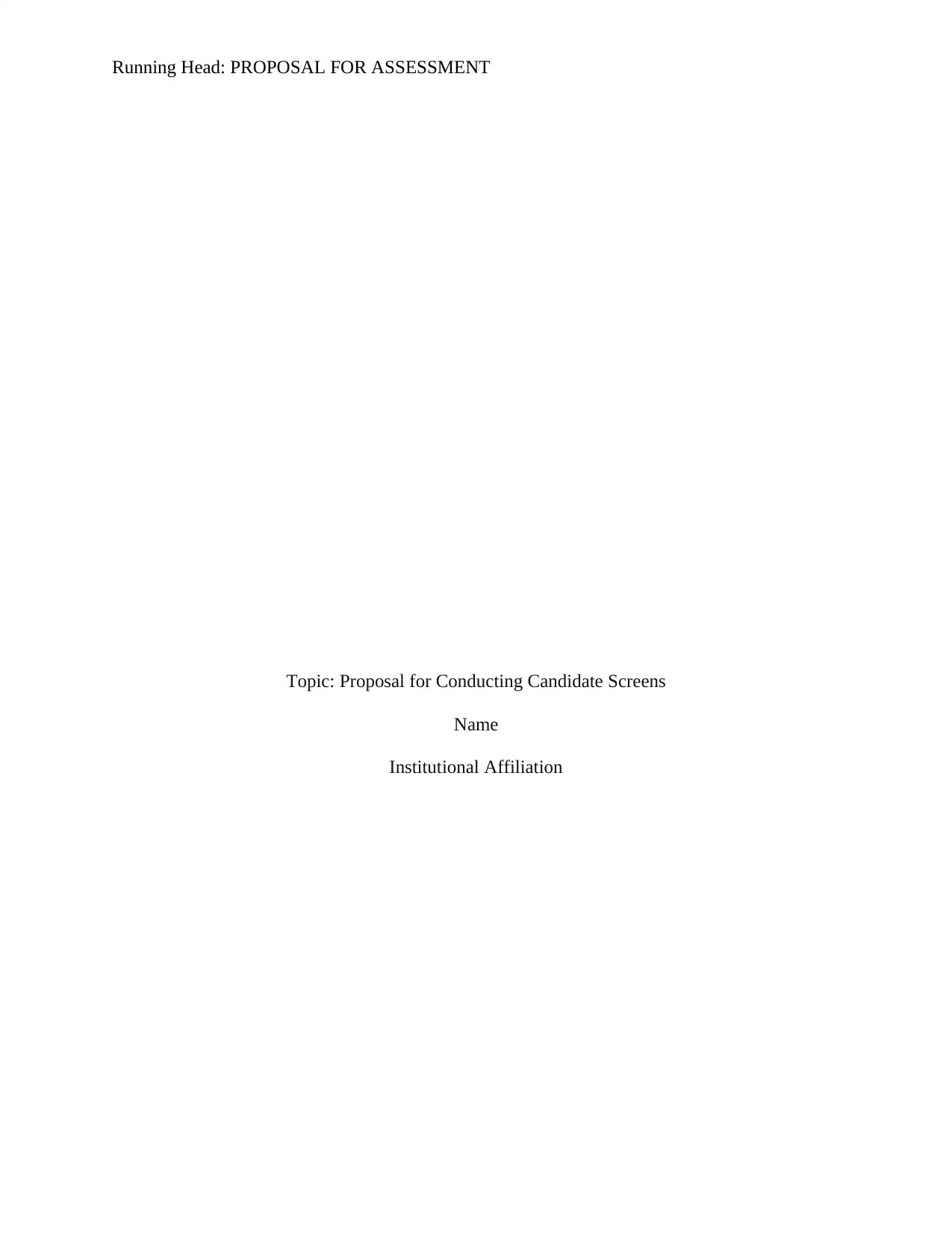
Running Head: PROPOSAL FOR ASSESSMENT
Topic: Proposal for Conducting Candidate Screens
Name
Institutional Affiliation
Topic: Proposal for Conducting Candidate Screens
Name
Institutional Affiliation
Paraphrase This Document
Need a fresh take? Get an instant paraphrase of this document with our AI Paraphraser
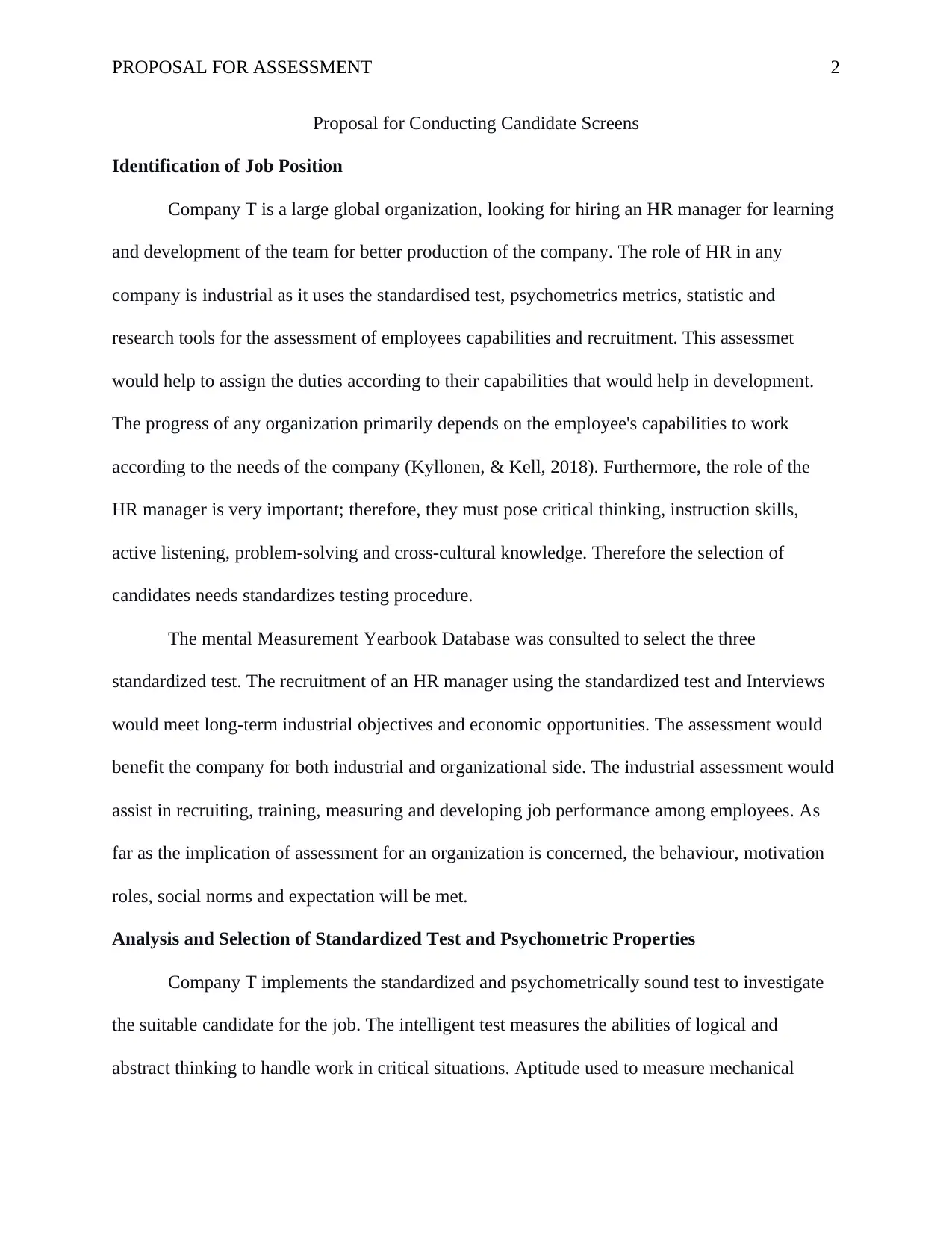
PROPOSAL FOR ASSESSMENT 2
Proposal for Conducting Candidate Screens
Identification of Job Position
Company T is a large global organization, looking for hiring an HR manager for learning
and development of the team for better production of the company. The role of HR in any
company is industrial as it uses the standardised test, psychometrics metrics, statistic and
research tools for the assessment of employees capabilities and recruitment. This assessmet
would help to assign the duties according to their capabilities that would help in development.
The progress of any organization primarily depends on the employee's capabilities to work
according to the needs of the company (Kyllonen, & Kell, 2018). Furthermore, the role of the
HR manager is very important; therefore, they must pose critical thinking, instruction skills,
active listening, problem-solving and cross-cultural knowledge. Therefore the selection of
candidates needs standardizes testing procedure.
The mental Measurement Yearbook Database was consulted to select the three
standardized test. The recruitment of an HR manager using the standardized test and Interviews
would meet long-term industrial objectives and economic opportunities. The assessment would
benefit the company for both industrial and organizational side. The industrial assessment would
assist in recruiting, training, measuring and developing job performance among employees. As
far as the implication of assessment for an organization is concerned, the behaviour, motivation
roles, social norms and expectation will be met.
Analysis and Selection of Standardized Test and Psychometric Properties
Company T implements the standardized and psychometrically sound test to investigate
the suitable candidate for the job. The intelligent test measures the abilities of logical and
abstract thinking to handle work in critical situations. Aptitude used to measure mechanical
Proposal for Conducting Candidate Screens
Identification of Job Position
Company T is a large global organization, looking for hiring an HR manager for learning
and development of the team for better production of the company. The role of HR in any
company is industrial as it uses the standardised test, psychometrics metrics, statistic and
research tools for the assessment of employees capabilities and recruitment. This assessmet
would help to assign the duties according to their capabilities that would help in development.
The progress of any organization primarily depends on the employee's capabilities to work
according to the needs of the company (Kyllonen, & Kell, 2018). Furthermore, the role of the
HR manager is very important; therefore, they must pose critical thinking, instruction skills,
active listening, problem-solving and cross-cultural knowledge. Therefore the selection of
candidates needs standardizes testing procedure.
The mental Measurement Yearbook Database was consulted to select the three
standardized test. The recruitment of an HR manager using the standardized test and Interviews
would meet long-term industrial objectives and economic opportunities. The assessment would
benefit the company for both industrial and organizational side. The industrial assessment would
assist in recruiting, training, measuring and developing job performance among employees. As
far as the implication of assessment for an organization is concerned, the behaviour, motivation
roles, social norms and expectation will be met.
Analysis and Selection of Standardized Test and Psychometric Properties
Company T implements the standardized and psychometrically sound test to investigate
the suitable candidate for the job. The intelligent test measures the abilities of logical and
abstract thinking to handle work in critical situations. Aptitude used to measure mechanical
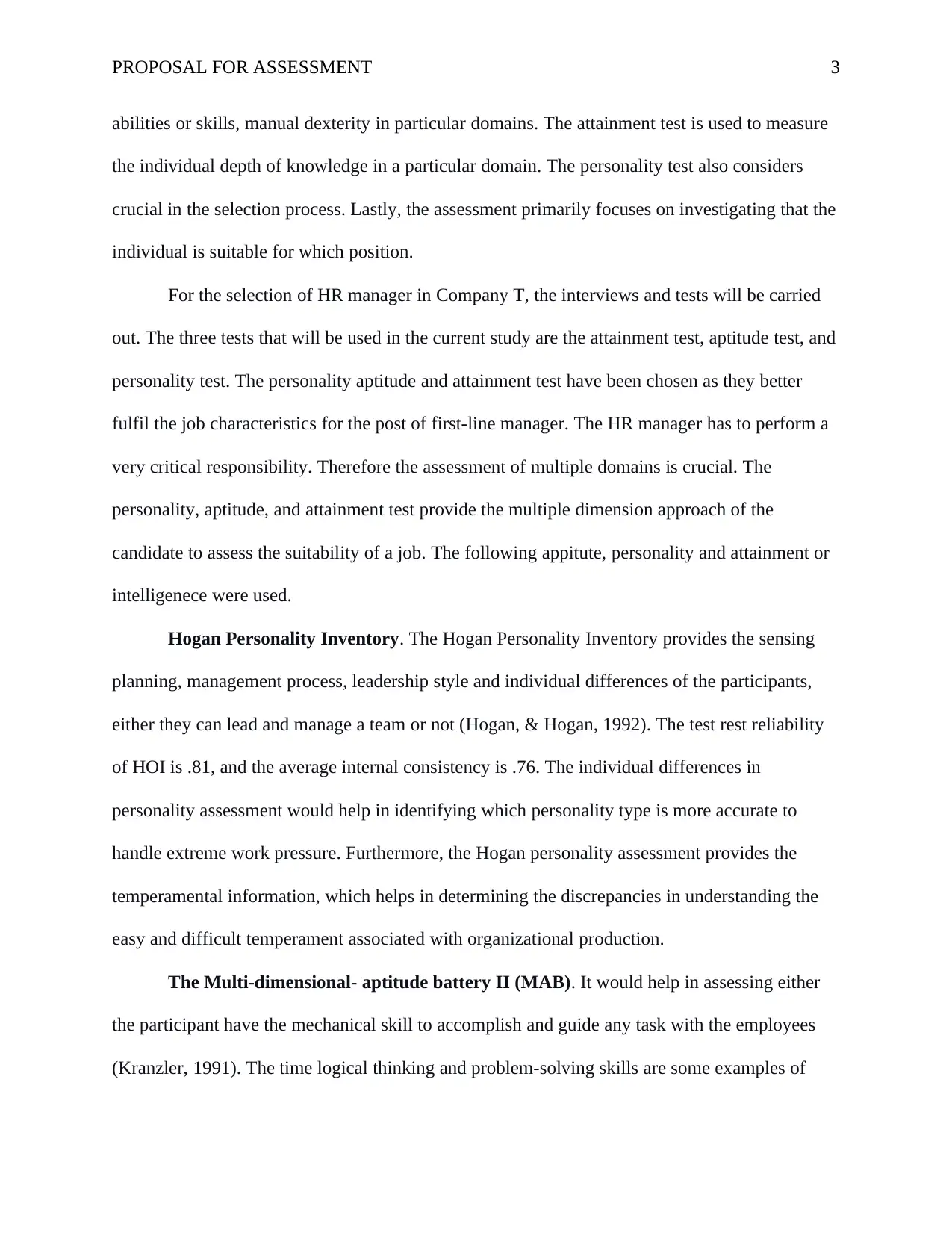
PROPOSAL FOR ASSESSMENT 3
abilities or skills, manual dexterity in particular domains. The attainment test is used to measure
the individual depth of knowledge in a particular domain. The personality test also considers
crucial in the selection process. Lastly, the assessment primarily focuses on investigating that the
individual is suitable for which position.
For the selection of HR manager in Company T, the interviews and tests will be carried
out. The three tests that will be used in the current study are the attainment test, aptitude test, and
personality test. The personality aptitude and attainment test have been chosen as they better
fulfil the job characteristics for the post of first-line manager. The HR manager has to perform a
very critical responsibility. Therefore the assessment of multiple domains is crucial. The
personality, aptitude, and attainment test provide the multiple dimension approach of the
candidate to assess the suitability of a job. The following appitute, personality and attainment or
intelligenece were used.
Hogan Personality Inventory. The Hogan Personality Inventory provides the sensing
planning, management process, leadership style and individual differences of the participants,
either they can lead and manage a team or not (Hogan, & Hogan, 1992). The test rest reliability
of HOI is .81, and the average internal consistency is .76. The individual differences in
personality assessment would help in identifying which personality type is more accurate to
handle extreme work pressure. Furthermore, the Hogan personality assessment provides the
temperamental information, which helps in determining the discrepancies in understanding the
easy and difficult temperament associated with organizational production.
The Multi-dimensional- aptitude battery II (MAB). It would help in assessing either
the participant have the mechanical skill to accomplish and guide any task with the employees
(Kranzler, 1991). The time logical thinking and problem-solving skills are some examples of
abilities or skills, manual dexterity in particular domains. The attainment test is used to measure
the individual depth of knowledge in a particular domain. The personality test also considers
crucial in the selection process. Lastly, the assessment primarily focuses on investigating that the
individual is suitable for which position.
For the selection of HR manager in Company T, the interviews and tests will be carried
out. The three tests that will be used in the current study are the attainment test, aptitude test, and
personality test. The personality aptitude and attainment test have been chosen as they better
fulfil the job characteristics for the post of first-line manager. The HR manager has to perform a
very critical responsibility. Therefore the assessment of multiple domains is crucial. The
personality, aptitude, and attainment test provide the multiple dimension approach of the
candidate to assess the suitability of a job. The following appitute, personality and attainment or
intelligenece were used.
Hogan Personality Inventory. The Hogan Personality Inventory provides the sensing
planning, management process, leadership style and individual differences of the participants,
either they can lead and manage a team or not (Hogan, & Hogan, 1992). The test rest reliability
of HOI is .81, and the average internal consistency is .76. The individual differences in
personality assessment would help in identifying which personality type is more accurate to
handle extreme work pressure. Furthermore, the Hogan personality assessment provides the
temperamental information, which helps in determining the discrepancies in understanding the
easy and difficult temperament associated with organizational production.
The Multi-dimensional- aptitude battery II (MAB). It would help in assessing either
the participant have the mechanical skill to accomplish and guide any task with the employees
(Kranzler, 1991). The time logical thinking and problem-solving skills are some examples of
⊘ This is a preview!⊘
Do you want full access?
Subscribe today to unlock all pages.

Trusted by 1+ million students worldwide
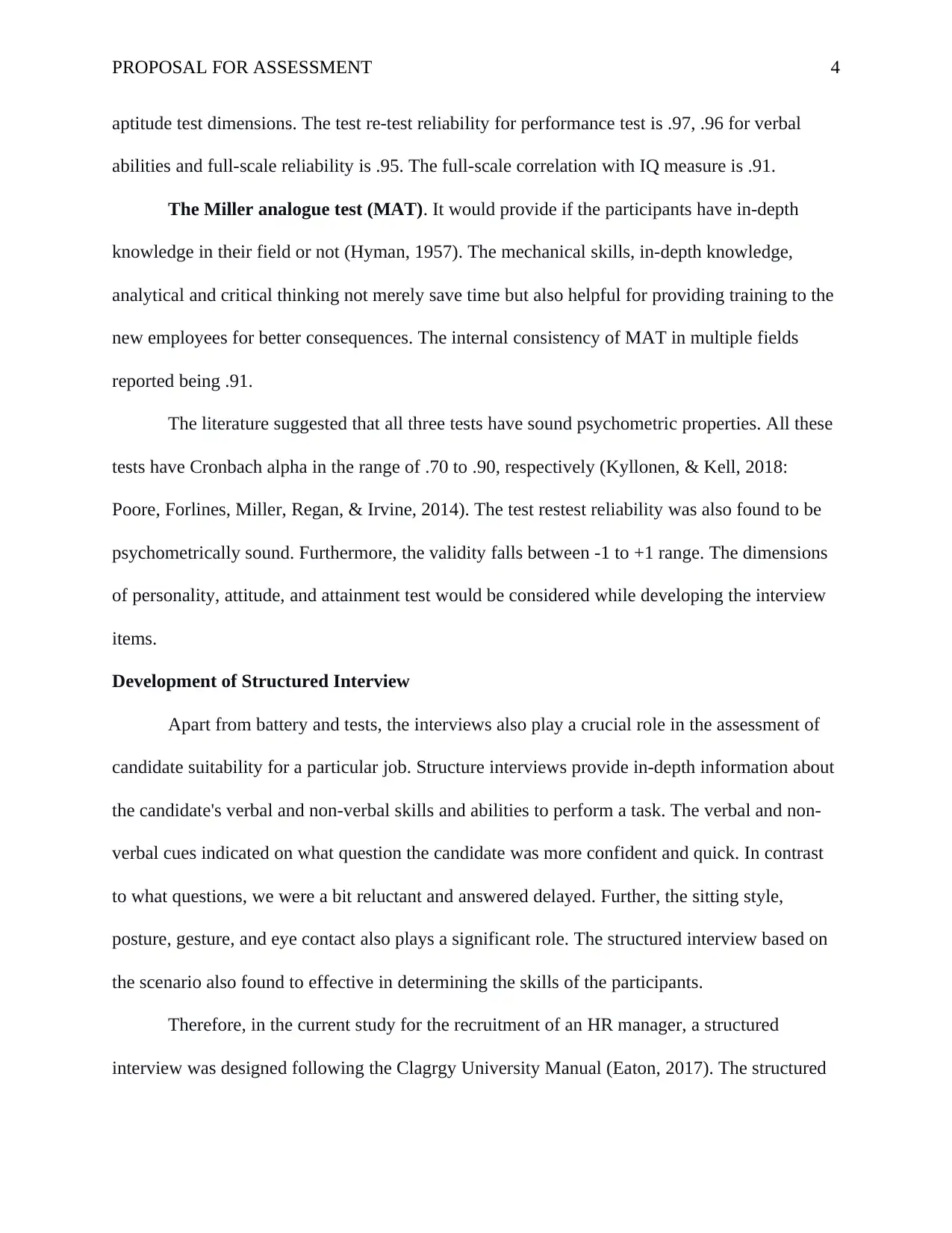
PROPOSAL FOR ASSESSMENT 4
aptitude test dimensions. The test re-test reliability for performance test is .97, .96 for verbal
abilities and full-scale reliability is .95. The full-scale correlation with IQ measure is .91.
The Miller analogue test (MAT). It would provide if the participants have in-depth
knowledge in their field or not (Hyman, 1957). The mechanical skills, in-depth knowledge,
analytical and critical thinking not merely save time but also helpful for providing training to the
new employees for better consequences. The internal consistency of MAT in multiple fields
reported being .91.
The literature suggested that all three tests have sound psychometric properties. All these
tests have Cronbach alpha in the range of .70 to .90, respectively (Kyllonen, & Kell, 2018:
Poore, Forlines, Miller, Regan, & Irvine, 2014). The test restest reliability was also found to be
psychometrically sound. Furthermore, the validity falls between -1 to +1 range. The dimensions
of personality, attitude, and attainment test would be considered while developing the interview
items.
Development of Structured Interview
Apart from battery and tests, the interviews also play a crucial role in the assessment of
candidate suitability for a particular job. Structure interviews provide in-depth information about
the candidate's verbal and non-verbal skills and abilities to perform a task. The verbal and non-
verbal cues indicated on what question the candidate was more confident and quick. In contrast
to what questions, we were a bit reluctant and answered delayed. Further, the sitting style,
posture, gesture, and eye contact also plays a significant role. The structured interview based on
the scenario also found to effective in determining the skills of the participants.
Therefore, in the current study for the recruitment of an HR manager, a structured
interview was designed following the Clagrgy University Manual (Eaton, 2017). The structured
aptitude test dimensions. The test re-test reliability for performance test is .97, .96 for verbal
abilities and full-scale reliability is .95. The full-scale correlation with IQ measure is .91.
The Miller analogue test (MAT). It would provide if the participants have in-depth
knowledge in their field or not (Hyman, 1957). The mechanical skills, in-depth knowledge,
analytical and critical thinking not merely save time but also helpful for providing training to the
new employees for better consequences. The internal consistency of MAT in multiple fields
reported being .91.
The literature suggested that all three tests have sound psychometric properties. All these
tests have Cronbach alpha in the range of .70 to .90, respectively (Kyllonen, & Kell, 2018:
Poore, Forlines, Miller, Regan, & Irvine, 2014). The test restest reliability was also found to be
psychometrically sound. Furthermore, the validity falls between -1 to +1 range. The dimensions
of personality, attitude, and attainment test would be considered while developing the interview
items.
Development of Structured Interview
Apart from battery and tests, the interviews also play a crucial role in the assessment of
candidate suitability for a particular job. Structure interviews provide in-depth information about
the candidate's verbal and non-verbal skills and abilities to perform a task. The verbal and non-
verbal cues indicated on what question the candidate was more confident and quick. In contrast
to what questions, we were a bit reluctant and answered delayed. Further, the sitting style,
posture, gesture, and eye contact also plays a significant role. The structured interview based on
the scenario also found to effective in determining the skills of the participants.
Therefore, in the current study for the recruitment of an HR manager, a structured
interview was designed following the Clagrgy University Manual (Eaton, 2017). The structured
Paraphrase This Document
Need a fresh take? Get an instant paraphrase of this document with our AI Paraphraser
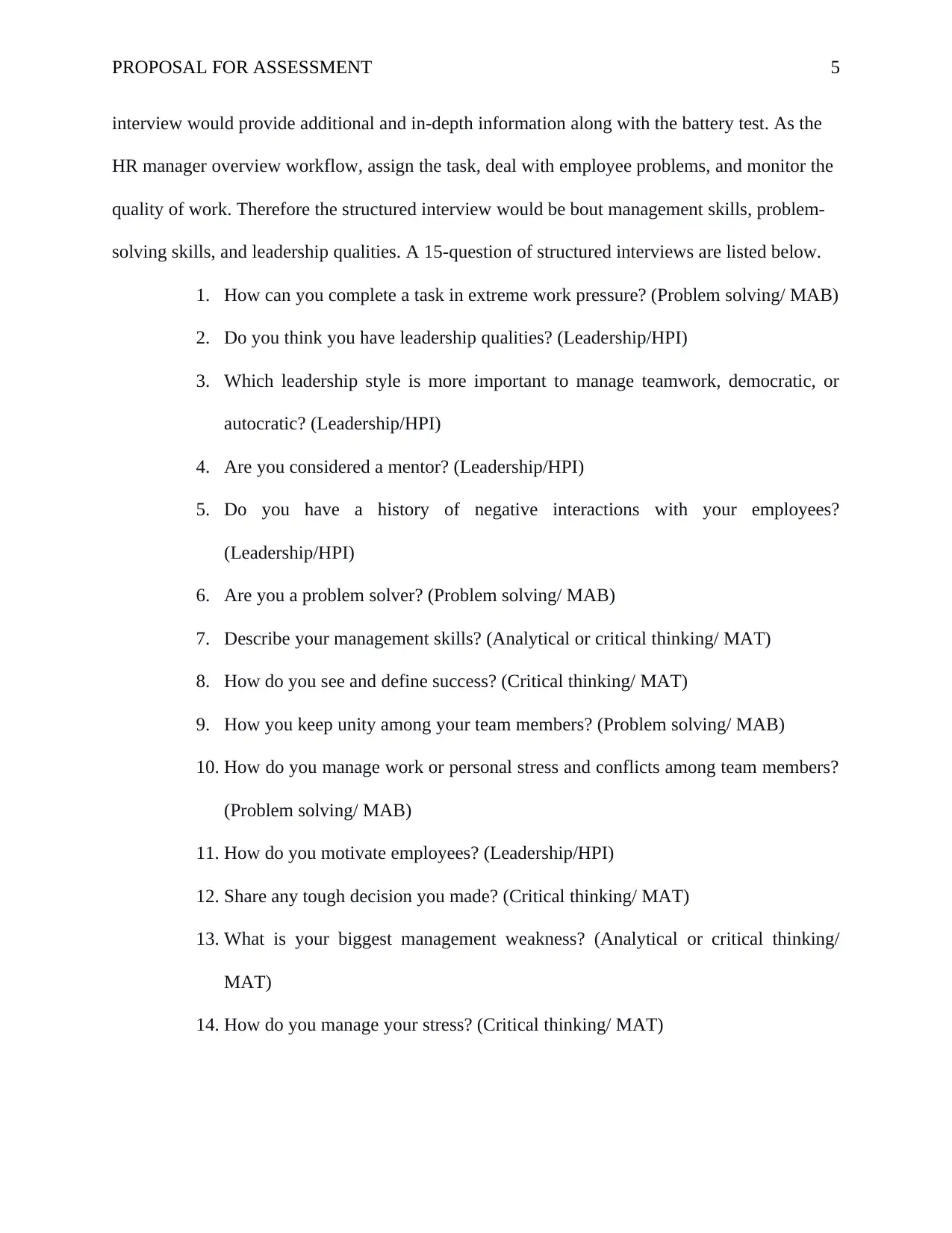
PROPOSAL FOR ASSESSMENT 5
interview would provide additional and in-depth information along with the battery test. As the
HR manager overview workflow, assign the task, deal with employee problems, and monitor the
quality of work. Therefore the structured interview would be bout management skills, problem-
solving skills, and leadership qualities. A 15-question of structured interviews are listed below.
1. How can you complete a task in extreme work pressure? (Problem solving/ MAB)
2. Do you think you have leadership qualities? (Leadership/HPI)
3. Which leadership style is more important to manage teamwork, democratic, or
autocratic? (Leadership/HPI)
4. Are you considered a mentor? (Leadership/HPI)
5. Do you have a history of negative interactions with your employees?
(Leadership/HPI)
6. Are you a problem solver? (Problem solving/ MAB)
7. Describe your management skills? (Analytical or critical thinking/ MAT)
8. How do you see and define success? (Critical thinking/ MAT)
9. How you keep unity among your team members? (Problem solving/ MAB)
10. How do you manage work or personal stress and conflicts among team members?
(Problem solving/ MAB)
11. How do you motivate employees? (Leadership/HPI)
12. Share any tough decision you made? (Critical thinking/ MAT)
13. What is your biggest management weakness? (Analytical or critical thinking/
MAT)
14. How do you manage your stress? (Critical thinking/ MAT)
interview would provide additional and in-depth information along with the battery test. As the
HR manager overview workflow, assign the task, deal with employee problems, and monitor the
quality of work. Therefore the structured interview would be bout management skills, problem-
solving skills, and leadership qualities. A 15-question of structured interviews are listed below.
1. How can you complete a task in extreme work pressure? (Problem solving/ MAB)
2. Do you think you have leadership qualities? (Leadership/HPI)
3. Which leadership style is more important to manage teamwork, democratic, or
autocratic? (Leadership/HPI)
4. Are you considered a mentor? (Leadership/HPI)
5. Do you have a history of negative interactions with your employees?
(Leadership/HPI)
6. Are you a problem solver? (Problem solving/ MAB)
7. Describe your management skills? (Analytical or critical thinking/ MAT)
8. How do you see and define success? (Critical thinking/ MAT)
9. How you keep unity among your team members? (Problem solving/ MAB)
10. How do you manage work or personal stress and conflicts among team members?
(Problem solving/ MAB)
11. How do you motivate employees? (Leadership/HPI)
12. Share any tough decision you made? (Critical thinking/ MAT)
13. What is your biggest management weakness? (Analytical or critical thinking/
MAT)
14. How do you manage your stress? (Critical thinking/ MAT)
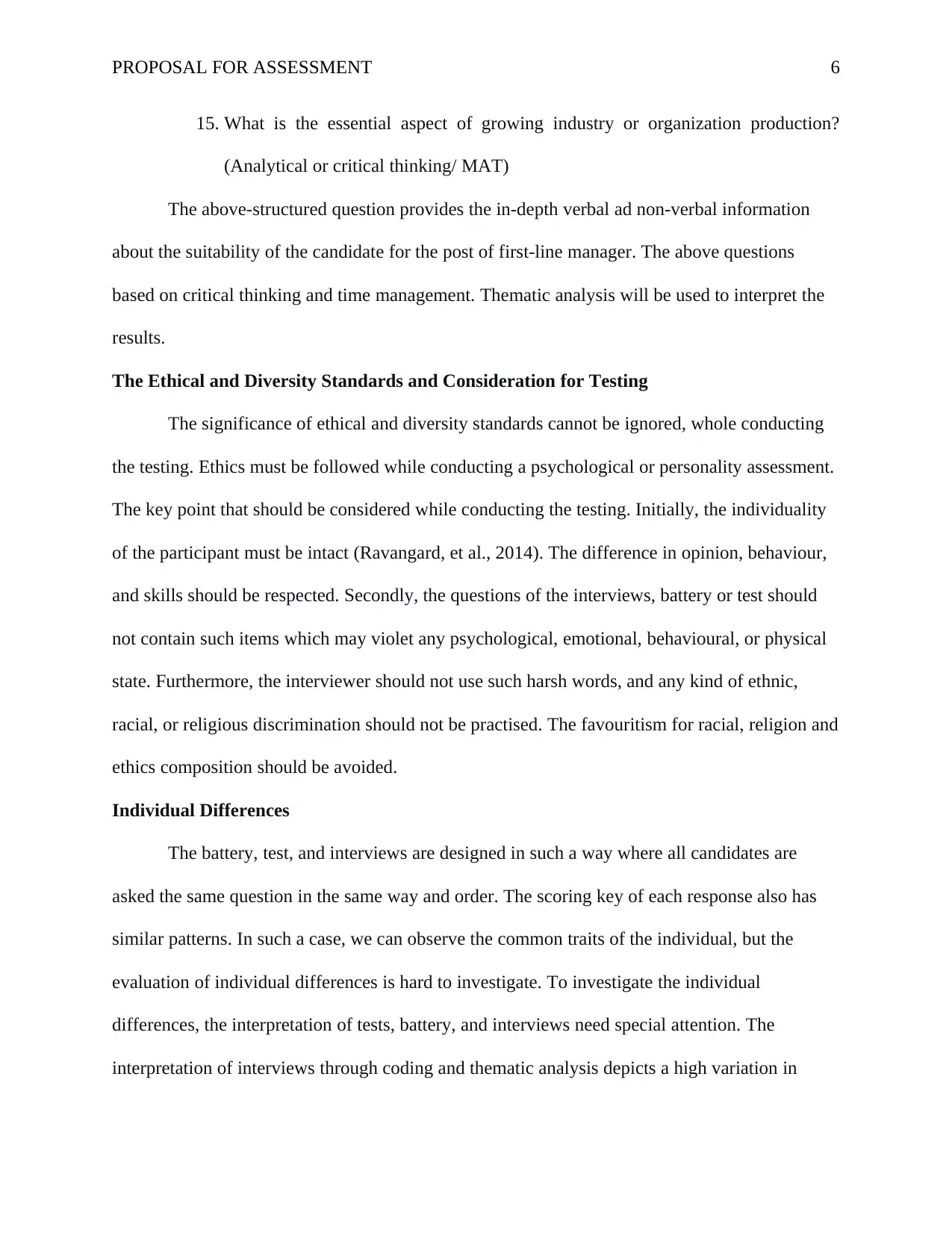
PROPOSAL FOR ASSESSMENT 6
15. What is the essential aspect of growing industry or organization production?
(Analytical or critical thinking/ MAT)
The above-structured question provides the in-depth verbal ad non-verbal information
about the suitability of the candidate for the post of first-line manager. The above questions
based on critical thinking and time management. Thematic analysis will be used to interpret the
results.
The Ethical and Diversity Standards and Consideration for Testing
The significance of ethical and diversity standards cannot be ignored, whole conducting
the testing. Ethics must be followed while conducting a psychological or personality assessment.
The key point that should be considered while conducting the testing. Initially, the individuality
of the participant must be intact (Ravangard, et al., 2014). The difference in opinion, behaviour,
and skills should be respected. Secondly, the questions of the interviews, battery or test should
not contain such items which may violet any psychological, emotional, behavioural, or physical
state. Furthermore, the interviewer should not use such harsh words, and any kind of ethnic,
racial, or religious discrimination should not be practised. The favouritism for racial, religion and
ethics composition should be avoided.
Individual Differences
The battery, test, and interviews are designed in such a way where all candidates are
asked the same question in the same way and order. The scoring key of each response also has
similar patterns. In such a case, we can observe the common traits of the individual, but the
evaluation of individual differences is hard to investigate. To investigate the individual
differences, the interpretation of tests, battery, and interviews need special attention. The
interpretation of interviews through coding and thematic analysis depicts a high variation in
15. What is the essential aspect of growing industry or organization production?
(Analytical or critical thinking/ MAT)
The above-structured question provides the in-depth verbal ad non-verbal information
about the suitability of the candidate for the post of first-line manager. The above questions
based on critical thinking and time management. Thematic analysis will be used to interpret the
results.
The Ethical and Diversity Standards and Consideration for Testing
The significance of ethical and diversity standards cannot be ignored, whole conducting
the testing. Ethics must be followed while conducting a psychological or personality assessment.
The key point that should be considered while conducting the testing. Initially, the individuality
of the participant must be intact (Ravangard, et al., 2014). The difference in opinion, behaviour,
and skills should be respected. Secondly, the questions of the interviews, battery or test should
not contain such items which may violet any psychological, emotional, behavioural, or physical
state. Furthermore, the interviewer should not use such harsh words, and any kind of ethnic,
racial, or religious discrimination should not be practised. The favouritism for racial, religion and
ethics composition should be avoided.
Individual Differences
The battery, test, and interviews are designed in such a way where all candidates are
asked the same question in the same way and order. The scoring key of each response also has
similar patterns. In such a case, we can observe the common traits of the individual, but the
evaluation of individual differences is hard to investigate. To investigate the individual
differences, the interpretation of tests, battery, and interviews need special attention. The
interpretation of interviews through coding and thematic analysis depicts a high variation in
⊘ This is a preview!⊘
Do you want full access?
Subscribe today to unlock all pages.

Trusted by 1+ million students worldwide
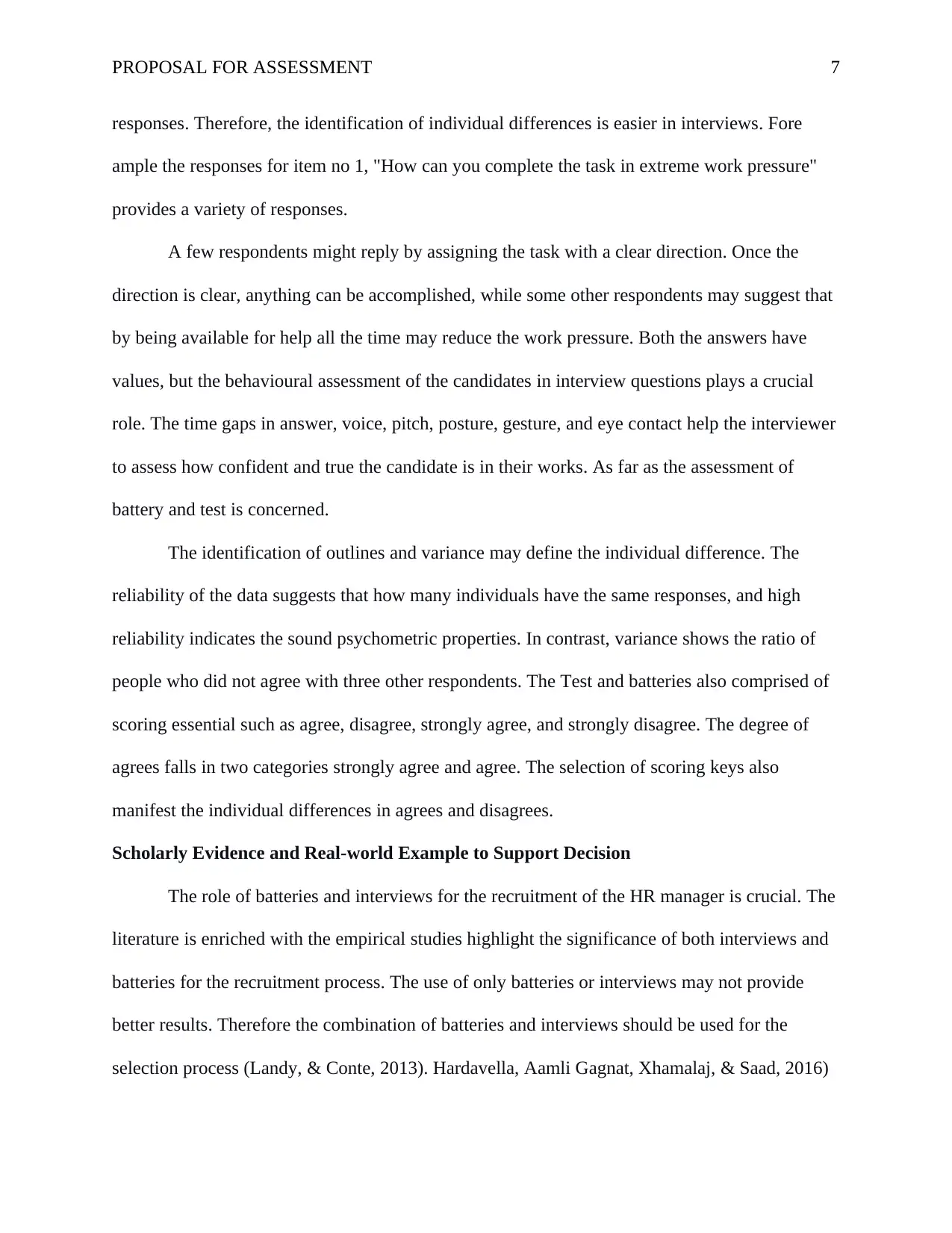
PROPOSAL FOR ASSESSMENT 7
responses. Therefore, the identification of individual differences is easier in interviews. Fore
ample the responses for item no 1, "How can you complete the task in extreme work pressure"
provides a variety of responses.
A few respondents might reply by assigning the task with a clear direction. Once the
direction is clear, anything can be accomplished, while some other respondents may suggest that
by being available for help all the time may reduce the work pressure. Both the answers have
values, but the behavioural assessment of the candidates in interview questions plays a crucial
role. The time gaps in answer, voice, pitch, posture, gesture, and eye contact help the interviewer
to assess how confident and true the candidate is in their works. As far as the assessment of
battery and test is concerned.
The identification of outlines and variance may define the individual difference. The
reliability of the data suggests that how many individuals have the same responses, and high
reliability indicates the sound psychometric properties. In contrast, variance shows the ratio of
people who did not agree with three other respondents. The Test and batteries also comprised of
scoring essential such as agree, disagree, strongly agree, and strongly disagree. The degree of
agrees falls in two categories strongly agree and agree. The selection of scoring keys also
manifest the individual differences in agrees and disagrees.
Scholarly Evidence and Real-world Example to Support Decision
The role of batteries and interviews for the recruitment of the HR manager is crucial. The
literature is enriched with the empirical studies highlight the significance of both interviews and
batteries for the recruitment process. The use of only batteries or interviews may not provide
better results. Therefore the combination of batteries and interviews should be used for the
selection process (Landy, & Conte, 2013). Hardavella, Aamli Gagnat, Xhamalaj, & Saad, 2016)
responses. Therefore, the identification of individual differences is easier in interviews. Fore
ample the responses for item no 1, "How can you complete the task in extreme work pressure"
provides a variety of responses.
A few respondents might reply by assigning the task with a clear direction. Once the
direction is clear, anything can be accomplished, while some other respondents may suggest that
by being available for help all the time may reduce the work pressure. Both the answers have
values, but the behavioural assessment of the candidates in interview questions plays a crucial
role. The time gaps in answer, voice, pitch, posture, gesture, and eye contact help the interviewer
to assess how confident and true the candidate is in their works. As far as the assessment of
battery and test is concerned.
The identification of outlines and variance may define the individual difference. The
reliability of the data suggests that how many individuals have the same responses, and high
reliability indicates the sound psychometric properties. In contrast, variance shows the ratio of
people who did not agree with three other respondents. The Test and batteries also comprised of
scoring essential such as agree, disagree, strongly agree, and strongly disagree. The degree of
agrees falls in two categories strongly agree and agree. The selection of scoring keys also
manifest the individual differences in agrees and disagrees.
Scholarly Evidence and Real-world Example to Support Decision
The role of batteries and interviews for the recruitment of the HR manager is crucial. The
literature is enriched with the empirical studies highlight the significance of both interviews and
batteries for the recruitment process. The use of only batteries or interviews may not provide
better results. Therefore the combination of batteries and interviews should be used for the
selection process (Landy, & Conte, 2013). Hardavella, Aamli Gagnat, Xhamalaj, & Saad, 2016)
Paraphrase This Document
Need a fresh take? Get an instant paraphrase of this document with our AI Paraphraser
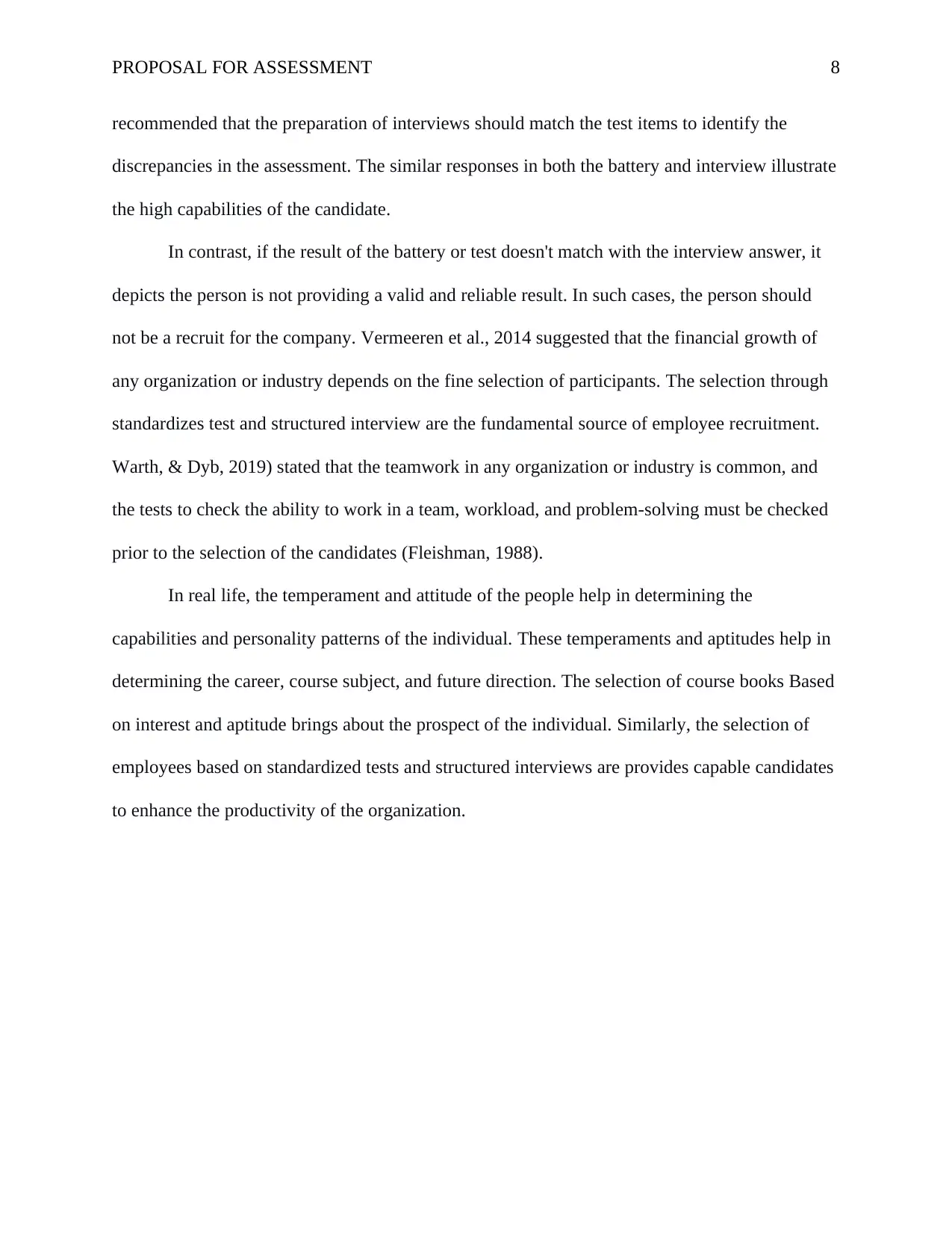
PROPOSAL FOR ASSESSMENT 8
recommended that the preparation of interviews should match the test items to identify the
discrepancies in the assessment. The similar responses in both the battery and interview illustrate
the high capabilities of the candidate.
In contrast, if the result of the battery or test doesn't match with the interview answer, it
depicts the person is not providing a valid and reliable result. In such cases, the person should
not be a recruit for the company. Vermeeren et al., 2014 suggested that the financial growth of
any organization or industry depends on the fine selection of participants. The selection through
standardizes test and structured interview are the fundamental source of employee recruitment.
Warth, & Dyb, 2019) stated that the teamwork in any organization or industry is common, and
the tests to check the ability to work in a team, workload, and problem-solving must be checked
prior to the selection of the candidates (Fleishman, 1988).
In real life, the temperament and attitude of the people help in determining the
capabilities and personality patterns of the individual. These temperaments and aptitudes help in
determining the career, course subject, and future direction. The selection of course books Based
on interest and aptitude brings about the prospect of the individual. Similarly, the selection of
employees based on standardized tests and structured interviews are provides capable candidates
to enhance the productivity of the organization.
recommended that the preparation of interviews should match the test items to identify the
discrepancies in the assessment. The similar responses in both the battery and interview illustrate
the high capabilities of the candidate.
In contrast, if the result of the battery or test doesn't match with the interview answer, it
depicts the person is not providing a valid and reliable result. In such cases, the person should
not be a recruit for the company. Vermeeren et al., 2014 suggested that the financial growth of
any organization or industry depends on the fine selection of participants. The selection through
standardizes test and structured interview are the fundamental source of employee recruitment.
Warth, & Dyb, 2019) stated that the teamwork in any organization or industry is common, and
the tests to check the ability to work in a team, workload, and problem-solving must be checked
prior to the selection of the candidates (Fleishman, 1988).
In real life, the temperament and attitude of the people help in determining the
capabilities and personality patterns of the individual. These temperaments and aptitudes help in
determining the career, course subject, and future direction. The selection of course books Based
on interest and aptitude brings about the prospect of the individual. Similarly, the selection of
employees based on standardized tests and structured interviews are provides capable candidates
to enhance the productivity of the organization.
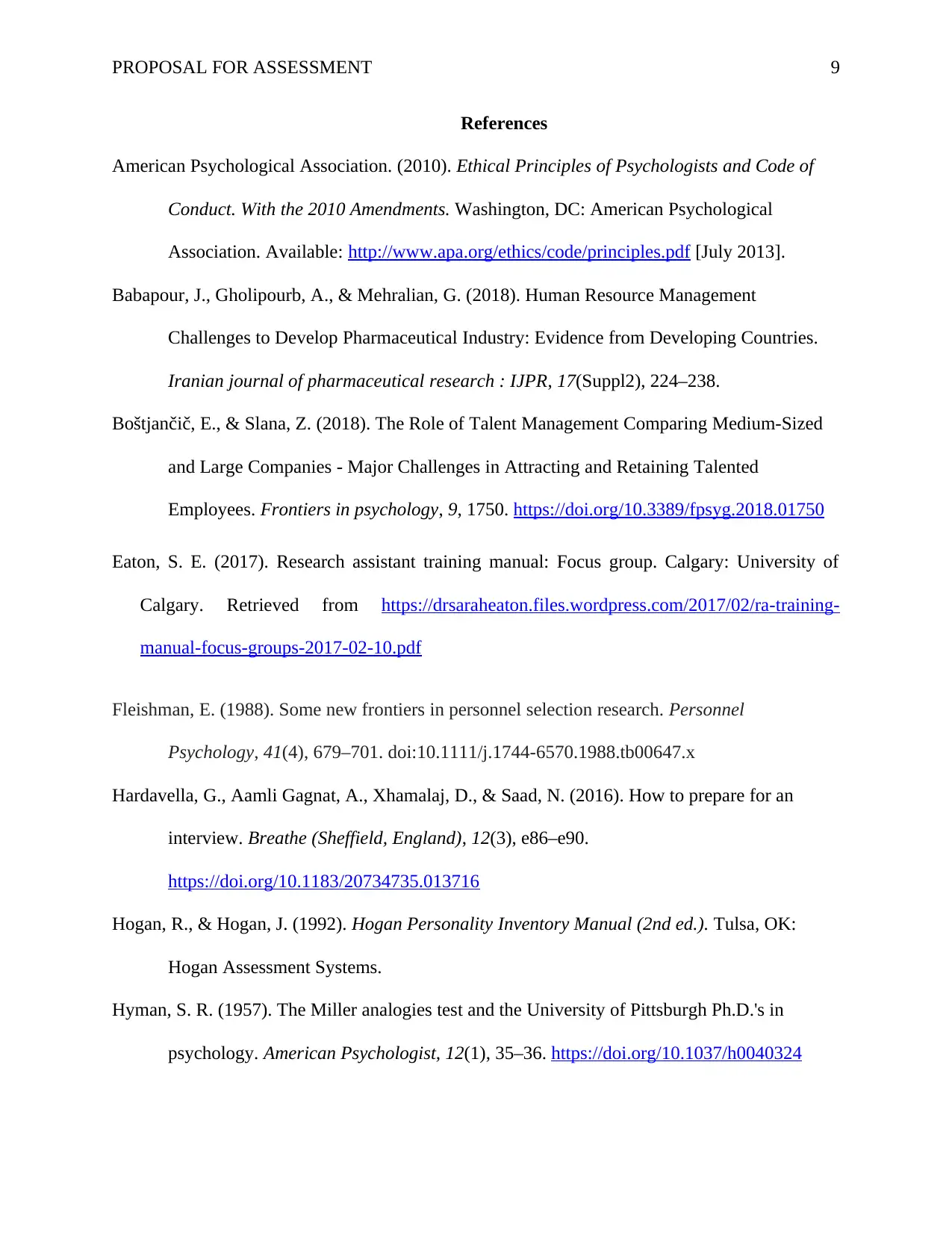
PROPOSAL FOR ASSESSMENT 9
References
American Psychological Association. (2010). Ethical Principles of Psychologists and Code of
Conduct. With the 2010 Amendments. Washington, DC: American Psychological
Association. Available: http://www.apa.org/ethics/code/principles.pdf [July 2013].
Babapour, J., Gholipourb, A., & Mehralian, G. (2018). Human Resource Management
Challenges to Develop Pharmaceutical Industry: Evidence from Developing Countries.
Iranian journal of pharmaceutical research : IJPR, 17(Suppl2), 224–238.
Boštjančič, E., & Slana, Z. (2018). The Role of Talent Management Comparing Medium-Sized
and Large Companies - Major Challenges in Attracting and Retaining Talented
Employees. Frontiers in psychology, 9, 1750. https://doi.org/10.3389/fpsyg.2018.01750
Eaton, S. E. (2017). Research assistant training manual: Focus group. Calgary: University of
Calgary. Retrieved from https://drsaraheaton.files.wordpress.com/2017/02/ra-training-
manual-focus-groups-2017-02-10.pdf
Fleishman, E. (1988). Some new frontiers in personnel selection research. Personnel
Psychology, 41(4), 679–701. doi:10.1111/j.1744-6570.1988.tb00647.x
Hardavella, G., Aamli Gagnat, A., Xhamalaj, D., & Saad, N. (2016). How to prepare for an
interview. Breathe (Sheffield, England), 12(3), e86–e90.
https://doi.org/10.1183/20734735.013716
Hogan, R., & Hogan, J. (1992). Hogan Personality Inventory Manual (2nd ed.). Tulsa, OK:
Hogan Assessment Systems.
Hyman, S. R. (1957). The Miller analogies test and the University of Pittsburgh Ph.D.'s in
psychology. American Psychologist, 12(1), 35–36. https://doi.org/10.1037/h0040324
References
American Psychological Association. (2010). Ethical Principles of Psychologists and Code of
Conduct. With the 2010 Amendments. Washington, DC: American Psychological
Association. Available: http://www.apa.org/ethics/code/principles.pdf [July 2013].
Babapour, J., Gholipourb, A., & Mehralian, G. (2018). Human Resource Management
Challenges to Develop Pharmaceutical Industry: Evidence from Developing Countries.
Iranian journal of pharmaceutical research : IJPR, 17(Suppl2), 224–238.
Boštjančič, E., & Slana, Z. (2018). The Role of Talent Management Comparing Medium-Sized
and Large Companies - Major Challenges in Attracting and Retaining Talented
Employees. Frontiers in psychology, 9, 1750. https://doi.org/10.3389/fpsyg.2018.01750
Eaton, S. E. (2017). Research assistant training manual: Focus group. Calgary: University of
Calgary. Retrieved from https://drsaraheaton.files.wordpress.com/2017/02/ra-training-
manual-focus-groups-2017-02-10.pdf
Fleishman, E. (1988). Some new frontiers in personnel selection research. Personnel
Psychology, 41(4), 679–701. doi:10.1111/j.1744-6570.1988.tb00647.x
Hardavella, G., Aamli Gagnat, A., Xhamalaj, D., & Saad, N. (2016). How to prepare for an
interview. Breathe (Sheffield, England), 12(3), e86–e90.
https://doi.org/10.1183/20734735.013716
Hogan, R., & Hogan, J. (1992). Hogan Personality Inventory Manual (2nd ed.). Tulsa, OK:
Hogan Assessment Systems.
Hyman, S. R. (1957). The Miller analogies test and the University of Pittsburgh Ph.D.'s in
psychology. American Psychologist, 12(1), 35–36. https://doi.org/10.1037/h0040324
⊘ This is a preview!⊘
Do you want full access?
Subscribe today to unlock all pages.

Trusted by 1+ million students worldwide
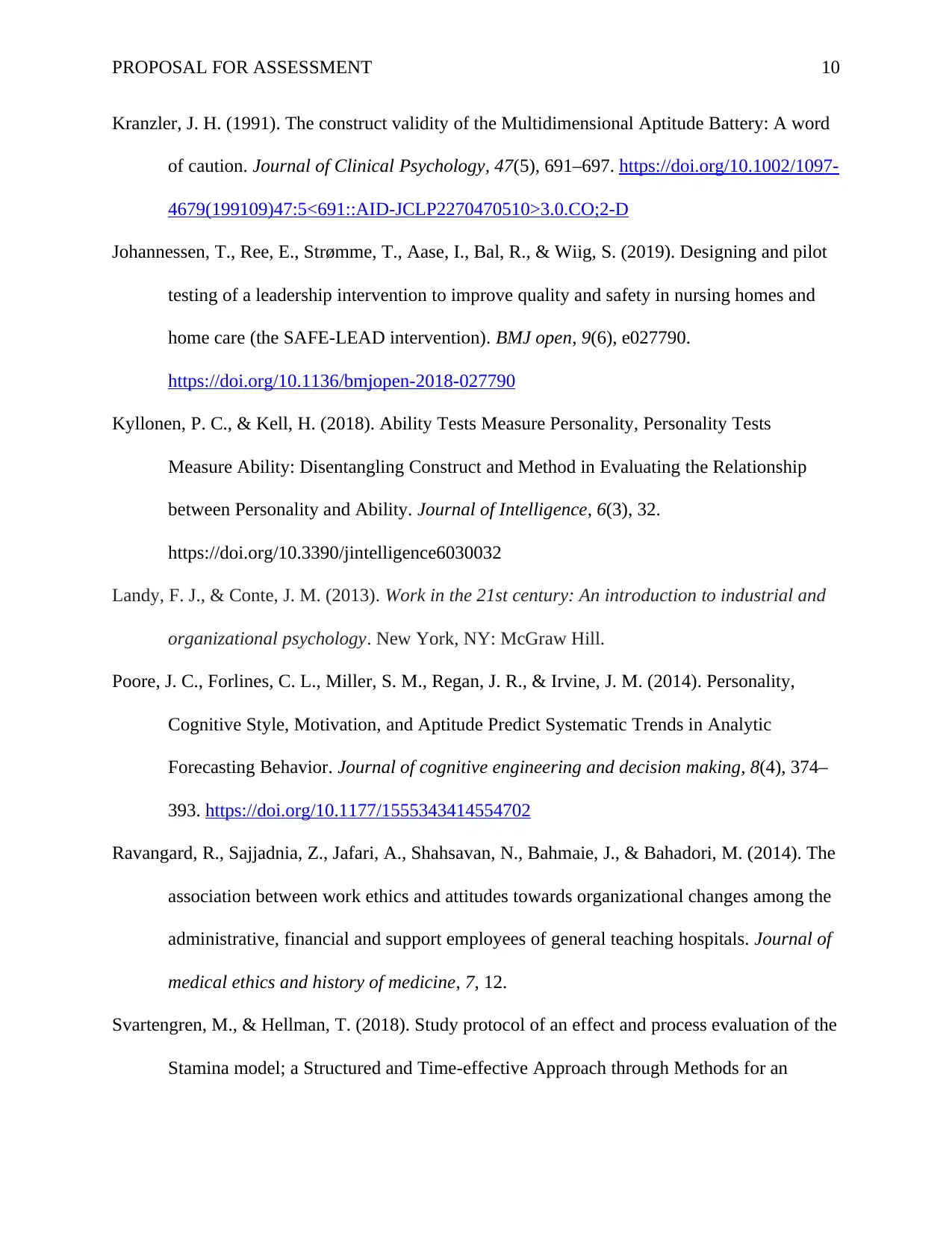
PROPOSAL FOR ASSESSMENT 10
Kranzler, J. H. (1991). The construct validity of the Multidimensional Aptitude Battery: A word
of caution. Journal of Clinical Psychology, 47(5), 691–697. https://doi.org/10.1002/1097-
4679(199109)47:5<691::AID-JCLP2270470510>3.0.CO;2-D
Johannessen, T., Ree, E., Strømme, T., Aase, I., Bal, R., & Wiig, S. (2019). Designing and pilot
testing of a leadership intervention to improve quality and safety in nursing homes and
home care (the SAFE-LEAD intervention). BMJ open, 9(6), e027790.
https://doi.org/10.1136/bmjopen-2018-027790
Kyllonen, P. C., & Kell, H. (2018). Ability Tests Measure Personality, Personality Tests
Measure Ability: Disentangling Construct and Method in Evaluating the Relationship
between Personality and Ability. Journal of Intelligence, 6(3), 32.
https://doi.org/10.3390/jintelligence6030032
Landy, F. J., & Conte, J. M. (2013). Work in the 21st century: An introduction to industrial and
organizational psychology. New York, NY: McGraw Hill.
Poore, J. C., Forlines, C. L., Miller, S. M., Regan, J. R., & Irvine, J. M. (2014). Personality,
Cognitive Style, Motivation, and Aptitude Predict Systematic Trends in Analytic
Forecasting Behavior. Journal of cognitive engineering and decision making, 8(4), 374–
393. https://doi.org/10.1177/1555343414554702
Ravangard, R., Sajjadnia, Z., Jafari, A., Shahsavan, N., Bahmaie, J., & Bahadori, M. (2014). The
association between work ethics and attitudes towards organizational changes among the
administrative, financial and support employees of general teaching hospitals. Journal of
medical ethics and history of medicine, 7, 12.
Svartengren, M., & Hellman, T. (2018). Study protocol of an effect and process evaluation of the
Stamina model; a Structured and Time-effective Approach through Methods for an
Kranzler, J. H. (1991). The construct validity of the Multidimensional Aptitude Battery: A word
of caution. Journal of Clinical Psychology, 47(5), 691–697. https://doi.org/10.1002/1097-
4679(199109)47:5<691::AID-JCLP2270470510>3.0.CO;2-D
Johannessen, T., Ree, E., Strømme, T., Aase, I., Bal, R., & Wiig, S. (2019). Designing and pilot
testing of a leadership intervention to improve quality and safety in nursing homes and
home care (the SAFE-LEAD intervention). BMJ open, 9(6), e027790.
https://doi.org/10.1136/bmjopen-2018-027790
Kyllonen, P. C., & Kell, H. (2018). Ability Tests Measure Personality, Personality Tests
Measure Ability: Disentangling Construct and Method in Evaluating the Relationship
between Personality and Ability. Journal of Intelligence, 6(3), 32.
https://doi.org/10.3390/jintelligence6030032
Landy, F. J., & Conte, J. M. (2013). Work in the 21st century: An introduction to industrial and
organizational psychology. New York, NY: McGraw Hill.
Poore, J. C., Forlines, C. L., Miller, S. M., Regan, J. R., & Irvine, J. M. (2014). Personality,
Cognitive Style, Motivation, and Aptitude Predict Systematic Trends in Analytic
Forecasting Behavior. Journal of cognitive engineering and decision making, 8(4), 374–
393. https://doi.org/10.1177/1555343414554702
Ravangard, R., Sajjadnia, Z., Jafari, A., Shahsavan, N., Bahmaie, J., & Bahadori, M. (2014). The
association between work ethics and attitudes towards organizational changes among the
administrative, financial and support employees of general teaching hospitals. Journal of
medical ethics and history of medicine, 7, 12.
Svartengren, M., & Hellman, T. (2018). Study protocol of an effect and process evaluation of the
Stamina model; a Structured and Time-effective Approach through Methods for an
Paraphrase This Document
Need a fresh take? Get an instant paraphrase of this document with our AI Paraphraser
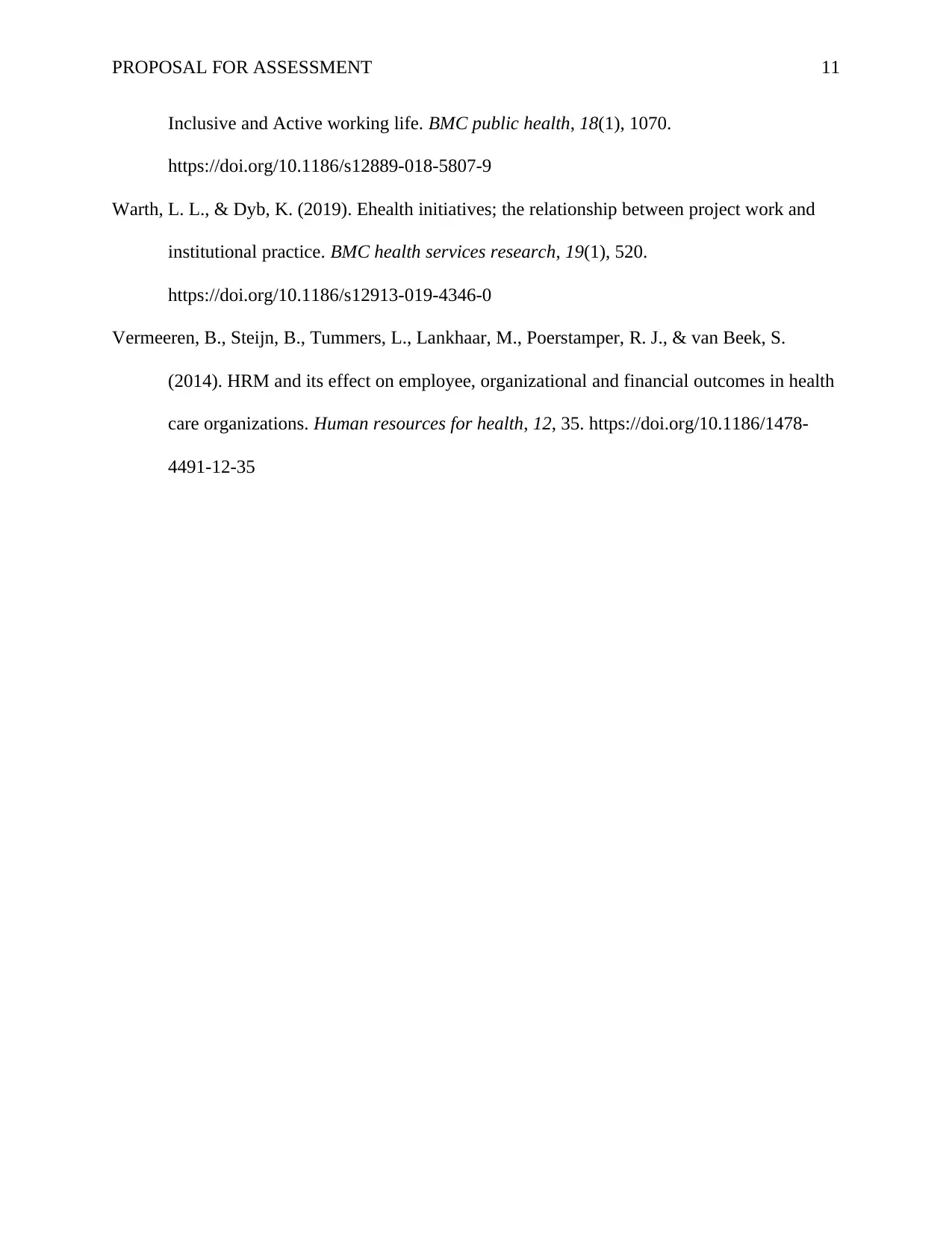
PROPOSAL FOR ASSESSMENT 11
Inclusive and Active working life. BMC public health, 18(1), 1070.
https://doi.org/10.1186/s12889-018-5807-9
Warth, L. L., & Dyb, K. (2019). Ehealth initiatives; the relationship between project work and
institutional practice. BMC health services research, 19(1), 520.
https://doi.org/10.1186/s12913-019-4346-0
Vermeeren, B., Steijn, B., Tummers, L., Lankhaar, M., Poerstamper, R. J., & van Beek, S.
(2014). HRM and its effect on employee, organizational and financial outcomes in health
care organizations. Human resources for health, 12, 35. https://doi.org/10.1186/1478-
4491-12-35
Inclusive and Active working life. BMC public health, 18(1), 1070.
https://doi.org/10.1186/s12889-018-5807-9
Warth, L. L., & Dyb, K. (2019). Ehealth initiatives; the relationship between project work and
institutional practice. BMC health services research, 19(1), 520.
https://doi.org/10.1186/s12913-019-4346-0
Vermeeren, B., Steijn, B., Tummers, L., Lankhaar, M., Poerstamper, R. J., & van Beek, S.
(2014). HRM and its effect on employee, organizational and financial outcomes in health
care organizations. Human resources for health, 12, 35. https://doi.org/10.1186/1478-
4491-12-35
1 out of 11
Related Documents
Your All-in-One AI-Powered Toolkit for Academic Success.
+13062052269
info@desklib.com
Available 24*7 on WhatsApp / Email
![[object Object]](/_next/static/media/star-bottom.7253800d.svg)
Unlock your academic potential
Copyright © 2020–2025 A2Z Services. All Rights Reserved. Developed and managed by ZUCOL.




